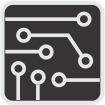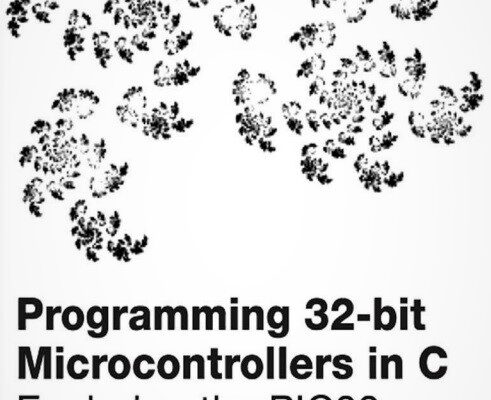Autor: Lucio Di Jasio
Editura: Elsevier
Anul aparitiei: 2008
Printed in the United States of America
Despre ce este vorba?
Pentru a intelege aceasta carte sunt necesare cunostinte de electronica embedded (in acest caz, programarea in C++).
Explicatiile si experimentele se fac pe familia de microcontrollere PIC32 fabricata de compania Microchip.
Structura cartii
Day 1: The Adventure Begins
- The Plan
- Preparation
- The Adventure Begins
- Compiling and Linking
- The Linker Script
- Building the First Project
- Using the Simulator
- Finding a Direction
- The JTAG Port
- Testing PORTB
- Mission Debriefing
- Notes for the Assembly Experts
- Notes for the PIC MCU Experts
- Notes for the C Experts
- Tips & Tricks
- Exercises
- Books
Day 2: Walking in Circles
- The Plan
- Preparation
- The Exploration
- While Loops
- An Animated Simulation
- Using the Logic Analyzer
- Debriefing
- Notes for the Assembly Experts
- Notes for the 8-Bit PIC Microcontroller Experts
- Notes for the 16-Bit PIC Microcontroller Experts
- Notes for the C Experts
- Notes for the MIPS Experts
- Tips & Tricks
- Notes on Using the Peripheral Libraries
- Exercises
- Books
Day 3: Message in a Bottle
- The Plan
- Preparation
- The Exploration
- Do Loops
- Variable Declarations
- for Loops
- More Loop Examples
- Arrays
- Sending a Message
- Testing with the Logic Analyzer
- Testing with the Explorer 16 Demonstration Board
- Testing with the PIC32 Starter Kit
- Debriefing
- Notes for the Assembly Experts
- Notes for the PIC Microcontroller Experts
- Notes for the C Experts
- Tips & Tricks
- Exercises
- Books
Day 4: NUMB3RS
- The Plan
- Preparation
- The Exploration
- On Optimizations (or Lack Thereof)
- Testing
- Going long long
- Integer Divisions
- Floating Point
- Measuring Performance
- Debriefing
- Notes for the Assembly Experts
- Notes for the 8-Bit PIC Microcontroller Experts
- Notes for the 16-Bit PIC and dsPIC Microcontroller Experts
- Tips & Tricks
- Exercises
- Books
Day 5: Interrupts
- The Plan
- Preparation
- The Exploration
- Interrupts and Exceptions
- Sources of Interrupt
- Interrupt Priorities
- Interrupt Handlers Declaration
- The Interrupt Management Library
- Single Vector Interrupt Management
- Managing Multiple Interrupts
- Multivectored Interrupt Management
- A Simple Application
- The Secondary Oscillator
- The Real-Time Clock Calendar (RTCC)
- Debriefing
- Notes for the PIC Microcontroller Experts
- Tips & Tricks
- Exercises
- Books
Day 6: Memory
- The Plan
- Preparation
- The Exploration
- Memory Space Allocation
- Looking at the MAP
- Pointers
- The Heap
- The PIC32MX Bus
- PIC32MX Memory Mapping
- The Embedded-Control Memory Map
- Debriefing
- Notes for the C Experts
- Notes for the Assembly Experts
- Notes for the PIC Microcontroller Experts
- Tips & Tricks
- Exercises
- Books
Day 7: Running
- The Plan
- Preparation
- The Exploration
- Performance vs. Power Consumption
- The Primary Oscillator Clock Chain
- The Peripheral Bus Clock
- Initial Device Configuration
- Setting Configuration Bits in Code
- Heavy Stuff
- Ready, Set, Go!
- Fine-Tuning the PIC32: Configuring Flash Wait States
- Fine-Tuning the PIC32: Enabling the Instruction and Data Cache
- Fine-Tuning the PIC32: Enabling the Instruction Pre-Fetch
- Fine-Tuning the PIC32: Final Notes
- Debriefing
- Notes for the Assembly Experts
- Notes for the PIC Microcontroller Experts
- Tips & Tricks
- Exercises
- Books
Day 8: Communication
- The Plan
- Preparation
- The Exploration
- Synchronous Serial Interfaces
- Asynchronous Serial Interfaces
- Parallel Interfaces
- Synchronous Communication Using the SPI Module
- Testing the Read Status Register Command
- Writing Data to the EEPROM
- Reading the Memory Contents
- A 32-bit Serial EEPROM Library
- Testing the New SEE Library
- Debriefing
- Notes for the C Experts
- Notes for the Explorer 16 Experts
- Notes for the PIC24 Experts
- Tips & Tricks
- Exercises
- Books
Day 9: Asynchronous Communication
- The Plan
- Preparation
- The Exploration
- UART Configuration
- Sending and Receiving Data
- Testing the Serial Communication Routines
- Building a Simple Console Library
- Testing a VT100 Terminal
- The Serial Port as a Debugging Tool
- The Matrix Project
- Debriefing
- Notes for the C Experts
- Notes for the PIC Microcontroller Experts
- Tips & Tricks
- Exercises
- Books
Day 10: Glass = Bliss
- The Plan
- Preparation
- The Exploration
- HD44780 Controller Compatibility
- The Parallel Master Port
- Configuring the PMP for LCD Module Control
- A Small Library of Functions to Access an LCD Display
- Building an LCD Library and Using the PMP Library
- Creating the include and lib Directories
- Advanced LCD Control
- Progress Bar Project
- Debriefing
- Notes for the PIC24 Experts
- Tips & Tricks
- Exercises
- Books
Day 11: It’s an Analog World
- The Plan
- Preparation
- The Exploration
- The First Conversion
- Automating Sampling Timing
- Developing a Demo
- Creating Our Own Mini ADC Library
- Fun and Games
- Sensing Temperature
- Debriefing
- Notes for the PIC24 Experts
- Tips & Tricks
- Exercises
- Books
Day 12: Capturing User Inputs
- The Plan
- Preparation
- Buttons and Mechanical Switches
- Button Input Packing
- Button Inputs Debouncing
- Rotary Encoders
- Interrupt-Driven Rotary Encoder Input
- Keyboards
- PS/2 Physical Interface
- The PS/2 Communication Protocol
- Interfacing the PIC32 to the PS/2
- Input Capture
- Testing Using a Stimulus Scripts
- The Simulator Profiler
- Change Notification
- Evaluating Cost
- I/O Polling
- Testing the I/O Polling Method
- Cost and Efficiency Considerations
- Keyboard Buffering
- Key Code Decoding
- Debriefing
- Notes for the PIC24 Experts
- Tips & Tricks
- Exercises
- Books
Day 13: UTube
- The Plan
- Preparation
- The Exploration
- Generating the Composite Video Signal
- The Output Compare Modules
- Image Buffers
- Serialization, DMA, and Synchronization
- Completing a Video Library
- Testing the Composite Video
- Measuring Performance
- Seeing the Dark Screen
- Test Pattern
- Plotting
- A Starry Night
- Line Drawing
- Bresenham Algorithm
- Plotting Math Functions
- Two-Dimensional Function Visualization
- Fractals
- Text
- Printing Text on Video
- Text Test
- The Matrix Reloaded
- Debriefing
- Notes for the PIC24 Experts
- Tips & Tricks
- Exercises
- Books
Day 14: Mass Storage
- The Plan
- Preparation
- The Exploration
- The Physical Interface
- Interfacing to the Explorer 16 Board
- Starting a New Project
- Selecting the SPI Mode of Operation
- Sending Commands in SPI Mode
- Completing the SD Card Initialization
- Reading Data from an SD/MMC Card
- Writing Data to an SD/MMC Card
- Testing the SD/MMC Interface
- Debriefing
- Tips & Tricks
- Exercises
- Books
Day 15: File I/O
- The Plan
- Preparation
- The Exploration
- Sectors and Clusters
- The File Allocation Table
- The Root Directory
- The Treasure Hunt
- Opening a File
- Reading Data from a File
- Closing a File
- The Fileio Module
- Testing fopenM() and freadM()
- Writing Data to a File
- Closing a File, Take Two
- Accessory Functions
- Testing the Complete Fileio Module
- Code Size
- Debriefing
- Tips & Tricks
- Exercises
- Books
Day 16: Musica, Maestro!
- The Plan
- Preparation
- The Exploration
- OC PWM Mode
- Testing the PWM as a D/A Converter
- Producing Analog Waveforms
- Reproducing Voice Messages
- A Media Player
- The WAVE File Format
- The Play() Function
- The Audio Routines
- A Simple WAVE File Player
- Debriefing
- Tips & Tricks
- Exercises

